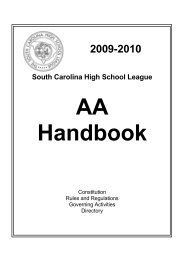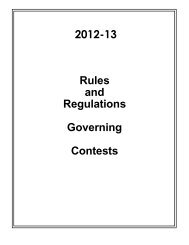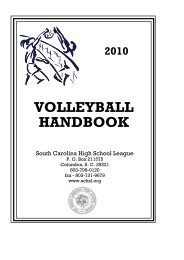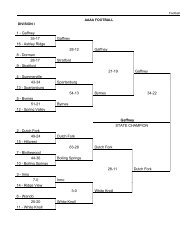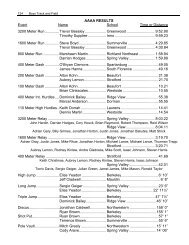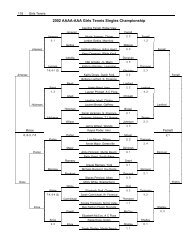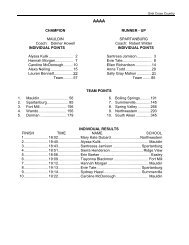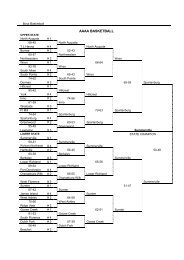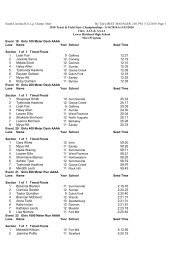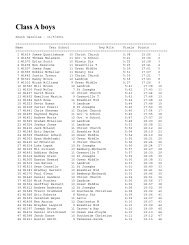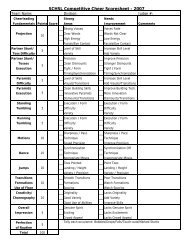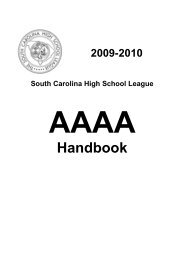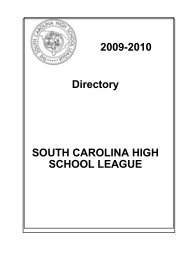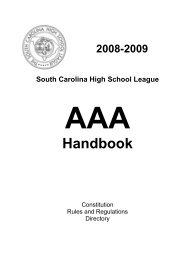Skin Lesion Form
Skin Lesion Form
Skin Lesion Form
Create successful ePaper yourself
Turn your PDF publications into a flip-book with our unique Google optimized e-Paper software.
NFHS MEDICAL RELEASE FORM<br />
FOR WRESTLER TO PARTICIPATE WITH SKIN LESION(S)<br />
The National Federation of State High School State Associations’ (NFHS) Sports Medicine Advisory Committee has developed a<br />
medical release form for wrestlers to participate with skin lesion(s) as a suggested model you may consider adopting for your state. The<br />
NFHS Sports Medicine Advisory Committee conducted a survey among specialty, academic, public health and primary care physicians<br />
and reviewed extensively the literature available on the communicability of various skin lesions at different stages of disease and<br />
treatment. No definitive data exists that allow us to absolutely predict when a lesion is no longer shedding organisms that could be<br />
transmitted to another wrestler. Another finding from the survey was the significant differences that exist among physicians relating to<br />
when they will permit a wrestler to return to participation after having a skin infection.<br />
Neither the NFHS nor the NFHS Sports Medicine Advisory Committee presumes to dictate to professionals how to practice medicine.<br />
Neither is the information on this form meant to establish a standard of care. The NFHS Sports Medicine Advisory Committee does<br />
feel, however, that the guidelines included on the form represent a summary consensus of the various responses obtained from the<br />
survey, from conversations and from the literature. The committee also feels that the components of the form are very relevant to<br />
addressing the concerns of coaches, parents, wrestlers and appropriate health-care professionals that led to the research into this<br />
subject and to the development of this form.<br />
GOALS FOR ESTABLISHING A WIDELY USED FORM:<br />
1. Protect wrestlers from exposure to communicable skin disorders. Although most of the skin lesions being discussed generally have<br />
no major long term consequences and are not life threatening, some do have morbidity associated with them and student-athletes<br />
should be protected from contracting skin disorders from other wrestlers or contaminated equipment such as mats.<br />
2. Allow wrestlers to participate as soon as it is reasonably safe for them and for their opponents and/or teammates using the same<br />
mat.<br />
3. Establish guidelines to help minimize major differences in management among appropriate health-care professionals who are<br />
signing “return to competition forms”. Consistent use of these guidelines should protect wrestlers from catching a skin disease<br />
from participation and should protect them from inequalities as to who can or cannot participate.<br />
4. Provide a basis to support appropriate health-care professional decisions on when a wrestler can or cannot participate. This should<br />
help the appropriate health-care professional who may face incredible pressure from many fronts to return a youngster to<br />
competition ASAP. This can involve any student athlete who never wins a match or the next state champion with a scholarship<br />
pending.<br />
IMPORTANT COMPONENTS FOR AN EFFECTIVE FORM:<br />
1. Each state association needs to determine which health-care professional can sign off on this form.<br />
2. Inclusion of the applicable NFHS wrestling rule so appropriate health-care professionals will understand that covering a<br />
contagious lesion is not an option that is allowed by rule. Covering a non-contagious lesion after adequate therapy to prevent<br />
injury to lesion is acceptable.<br />
3. Inclusion of the date and nature of treatment and the earliest date a wrestler can return to participation. This should minimize the<br />
need for a family to incur the expense of additional office visits as occurs when a form must be signed within three days of<br />
wrestling as some do.<br />
4. Inclusion of a “bodygram” with front and back views should clearly identify the lesion in question. Using non-black ink to<br />
designate skin lesions should result in less confusion or conflict. Also including the number of lesions protects against spread<br />
after a visit with an appropriate health-care professional.<br />
5. Inclusion of guidelines for minimum treatment before returning the wrestler to action as discussed above. This should enhance the<br />
likelihood that all wrestlers are managed safely and fairly.<br />
6. Inclusion of all of the components discussed has the potential to remove the referee from making a medical decision. If a lesion is<br />
questioned, the referee’s role could appropriately be only to see if the coach can provide a fully completed medical release form<br />
allowing the wrestler to wrestle.<br />
This form may be reproduced, if desired and can be edited in anyway for use by various individuals or organizations. In addition, the<br />
NFHS Sports Medicine Advisory Committee would welcome comments for inclusion in future versions as this will continue to be a<br />
work in progress.<br />
Revised/Approved by NFHS SMAC - April 2012
National Federation of State High School Associations<br />
Sports Medicine Advisory Committee<br />
MEDICAL RELEASE FOR WRESTLER TO PARTICIPATE WITH SKIN LESION<br />
Name: _________________________________________________________<br />
Diagnosis _________________________________________<br />
Date of Exam: ___ / ____ / ___<br />
Mark Location AND Number of <strong>Lesion</strong>(s)<br />
__________________________________________________<br />
Location AND Number of <strong>Lesion</strong>(s) ______________________<br />
____________________________________________________<br />
Medication(s) used to treat lesion(s): _______________________<br />
_____________________________________________________<br />
Date Treatment Started: ___ / ____ / ____<br />
<strong>Form</strong> Expiration Date: ___ / ____ / ____<br />
Earliest Date may return to participation: ____ / ____ / ____<br />
Provider Signature ________________________________________ Office Phone #: ______________________<br />
Provider Name (Must be legible) _______________________________________________________________<br />
Office Address _______________________________________________________________________________<br />
Note to Appropriate Health-Care Professionals: Non-contagious lesions do not require treatment prior to return to participation (e.g. eczema, psoriasis, etc.). Please<br />
familiarize yourself with NFHS Rules 4-2-3, 4-2-4 and 4-2-5 which states:<br />
“ART. 3 . . . If a participant is suspected by the referee or coach of having a communicable skin disease or any other condition that makes participation appear<br />
inadvisable, the coach shall provide current written documentation as defined by the NFHS or the state associations, from an appropriate health-care professional<br />
stating that the suspected disease or condition is not communicable and that the athlete’s participation would not be harmful to any opponent. This document<br />
shall be furnished at the weigh-in for the dual meet or tournament. The only exception would be if a designated, on-site meet appropriate health-care professional<br />
is present and is able to examine the wrestler either immediately prior to or immediately after the weigh-in. Covering a communicable condition shall not be<br />
considered acceptable and does not make the wrestler eligible to participate.”<br />
“ART. 4 . . . If a designated on-site meet appropriate health-care professional is present, he/she may overrule the diagnosis of the appropriate health-care<br />
professional signing the medical release form for a wrestler to participate or not participate with a particular skin condition.”<br />
“ART. 5 . . . A contestant may have documentation from an appropriate health-care professional only indicating a specific condition such as a birthmark or other<br />
non-communicable skin conditions such as psoriasis and eczema, and that documentation is valid for the duration of the season. It is valid with the understanding<br />
that a chronic condition could become secondarily infected and may require re-evaluation.”<br />
Once a lesion is not considered contagious, it may be covered to allow participation.<br />
Below are some treatment guidelines that suggest MINIMUM TREATMENT before return to wrestling:<br />
Bacterial Diseases (impetigo, boils): To be considered “non-contagious,” all lesions must be scabbed over with no oozing or discharge and no new lesions should<br />
have occurred in the preceding 48 hours. Oral antibiotic for three days is considered a minimum to achieve that status. If new lesions continue to develop or drain<br />
after 72 hours, MRSA (Methicillin Resistant Staphylococcus Aureus) should be considered and minimum oral antibiotics should be extended to 10 days before<br />
returning the athlete to competition or until all lesions are scabbed over, whichever occurs last.<br />
Herpetic <strong>Lesion</strong>s (Simplex, fever blisters/cold sores, Zoster, Gladiatorum): To be considered “non-contagious,” all lesions must be scabbed over with no oozing or<br />
discharge and no new lesions should have occurred in the preceding 48 hours. For primary (first episode of Herpes Gladiatorum), wrestlers should be treated and not<br />
allowed to compete for a minimum of 10 days. If general body signs and symptoms like fever and swollen lymph nodes are present, that minimum period of<br />
treatment should be extended to 14 days. Recurrent outbreaks require a minimum of 120 hours or five full days of oral anti-viral treatment, again so long as no new<br />
lesions have developed and all lesions are scabbed over.<br />
Tinea <strong>Lesion</strong>s (ringworm scalp, skin): Oral or topical treatment for 72 hours on skin and 14 days on scalp.<br />
Scabies, Head Lice: 24 hours after appropriate topical management.<br />
Conjunctivitis (Pink Eye): 24 hours of topical or oral medication and no discharge.<br />
Revised/Approved by NFHS SMAC - April 2012



